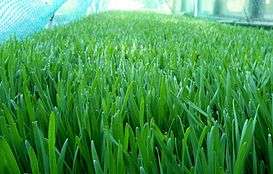Wheatgrass



Wheatgrass is a food prepared from the cotyledons of the common wheat plant, Triticum aestivum (subspecies of the family Poaceae). It is sold either as a juice or powder concentrate. Wheatgrass differs from wheat malt in that it is served freeze-dried or fresh, while wheat malt is convectively dried. Wheatgrass is allowed to grow longer than malt. Like most plants, it contains chlorophyll, amino acids, minerals, vitamins, and enzymes. Claims about the health benefits of wheatgrass range from providing supplemental nutrition to having unique curative properties, though few, if any, have been scientifically proven. It is often available in juice bars, and some consumers grow and juice wheatgrass in their homes. It is available as fresh produce, tablets, frozen juice and powder. Wheatgrass is also available commercially as a spray, cream, gel, massage lotion, and a liquid herbal supplement. Because wheatgrass juice is extracted from wheatgrass sprouts, i.e., before the wheat seed begins to form, it is gluten-free.
History
Wheat grass can be traced back in history over 5000 years, to ancient Egypt and perhaps even early Mesopotamian civilizations. It is purported that ancient Egyptians found sacred the young leafy blades of wheat and prized them for their positive effect on their health and vitality.[1]
The consumption of wheatgrass in the Western world began in the 1930s as a result of experiments conducted by Charles Schnabel in his attempts to popularize the plant.[2] By 1940, cans of Schnabel's powdered grass were on sale in major drug stores throughout the United States and Canada[3]
Ann Wigmore was also a strong advocate for the consumption of wheatgrass as a part of a raw food diet. Wigmore, founder of the Hippocrates Health Institute, believed that wheatgrass, as a part of a raw food diet, would cleanse the body of toxins while providing a proper balance of nutrients as a whole food. She also taught that wheatgrass could be used to treat those with serious disease. Wigmore's recommendations and reputation as a health practitioner have been heavily criticized, but many health institutes still endorse her teachings.[4]
Cultivation

Wheatgrass can be grown indoors or outdoors. A common method for sprout production indoors is often on trays in a growth medium such as a potting mix. Leaves are harvested when they develop a "split" as another leaf emerges. These can then be cut off with scissors and allow a second crop of shoots to form. Sometimes a third cutting is possible, but may be tougher and have less sugars than the first.[5]
Schnabel's research was conducted with wheatgrass grown outdoors in Kansas. His wheatgrass required 200 days of slow growth, through the winter and early spring, when it was harvested at the jointing stage. He claimed that at this stage the plant reached its peak nutritional value; after jointing, concentrations of chlorophyll, protein, and vitamins decline sharply.[6] Wheatgrass grown is harvested, dehydrated at a low temperature and sold in tablet and powdered concentrates for human and animal consumption. Indoor grown wheatgrass is used to make wheatgrass juice powder.
Health claims
| Table 1. Nutrient comparison of 1 oz (28.35 g) of wheatgrass juice, broccoli and spinach. | |||
|---|---|---|---|
| Nutrient | Wheatgrass Juice | Broccoli | Spinach |
| Protein | 860 mg | 800 mg | 810 mg |
| Beta-carotene | 120 IU | 177 IU | 2658 IU |
| Vitamin E | 880 mcg | 220 mcg | 580 mcg |
| Vitamin C | 1 mg | 25.3 mg | 8 mg |
| Vitamin B12 | 0.30 mcg | 0 mcg | 0 mcg |
| Phosphorus | 21 mg | 19 mg | 14 mg |
| Magnesium | 8 mg | 6 mg | 22 mg |
| Calcium | 7.2 mg | 13 mg | 28 mg |
| Iron | 0.66 mg | 0.21 mg | 0.77 mg |
| Potassium | 42 mg | 90 mg | 158 mg |
| Data on broccoli and spinach from USDA database.[7] Data on Wheatgrass juice from indoor grown wheatgrass.[3] | |||
Proponents of wheatgrass make many claims for its health properties, ranging from promotion of general well-being to cancer prevention. However, according to the American Cancer Society, "available scientific evidence does not support the idea that wheatgrass or the wheatgrass diet can cure or prevent disease".[8]
A small 2002 study showed some evidence that wheatgrass might help with the symptoms of ulcerative colitis, but without further work the significance of this work cannot be determined.[9] Another small 2002 study suggested wheatgrass might help with the side-effects of breast cancer chemotherapy.[10]
Nutritional content
Wheatgrass is a source of potassium, dietary fiber, vitamin A, vitamin C, vitamin E (alpha tocopherol), vitamin K, thiamin, riboflavin, niacin, vitamin B6, pantothenic acid, iron, zinc, copper, manganese and selenium. Wheatgrass is also a source of protein (less than one gram per 28 grams). Adding other foods with complementary amino acid profiles to this food may yield a more complete protein source and improve the quality of some types of restrictive diets.[11]
Wheatgrass proponent Charles Schnabel claimed in the 1940s that "fifteen pounds of wheatgrass is equal in overall nutritional value to 350 pounds of ordinary garden vegetables",[3] a ratio of 1:23.[6] Despite claims of vitamin and mineral content disproportional to other vegetables, the nutrient content of wheatgrass juice is roughly equivalent to that of dark leafy vegetables (see table 1).
Contrary to popular belief, vitamin B12 is not contained within wheatgrass or any vegetable; rather it is a byproduct of the microorganisms living on plants.[12] Some analyses of B12 content in wheatgrass have confirmed that it contains negligible amounts of the compound even though the source of this analysis remains unclear.[13] The USDA National Nutrient Database reports that wheatgrass contains no vitamin B12.[7] Because vitamin B12 is not made by plants, any of this vitamin would have to be produced by bacteria found in the preparation.
See also
- List of juices
-
.svg.png) Drink portal
Drink portal
References
- ↑ Seymour, Kent. "WHEAT GRASS (Triticum aestivum)" (PDF). Illinois State University. Retrieved 11 December 2013.
- ↑ Murphy, Sean (2002-10-13). "Wheatgrass, healthy for the body and the bank account". ABC Landline. Retrieved 2006-10-06.
- 1 2 3 Meyerowitz, Steve (April 1999). "Nutrition in Grass". Wheatgrass Nature's Finest Medicine: The Complete Guide to Using Grass Foods & Juices to Revitalize Your Health (6th ed.). Book Publishing Company. p. 53. ISBN 1-878736-97-3.
- ↑ Jarvis, William (2001-01-18). "Wheatgrass Therapy". The National Council Against Health Fraud.
- ↑ "4 Ways to Grow Wheatgrass". WikiHow. Retrieved 11 December 2013.
- 1 2 "Site Dedication and Construction Preliminaries, 1921-1923". Ahr-kc.com. Retrieved 2013-04-19.
- 1 2 "USDA Nutrient Database". Retrieved 2007-11-06.
- ↑ "Wheatgrass". American Cancer Society. November 2008. Retrieved August 2013. Check date values in:
|access-date=(help) - ↑ "Wheat grass | Memorial Sloan-Kettering Cancer Center". Mskcc.org. Retrieved 2013-04-19.
- ↑ "What is wheatgrass?". WebMD. Retrieved 11 December 2013.
- ↑ "Nutrition Facts and Analysis for wheat grass". Nutrition Data. Retrieved 11 December 2013.
- ↑ Melina, Vesanto, MS, RD & Davis, Brenda, RD: "The New Becoming Vegetarian", page 186–187. Healthy Living Publications, 2003.
- ↑ "Nutrition Facts and Analysis for wheat grass". Nutritiondata.self.com. Retrieved 2013-04-19.
External links
| Wikimedia Commons has media related to Wheatgrass. |
- Wheatgrass Juice: Is the magical mystery juice all it's blended up to be? Skeptoid: Critical Analysis of Pop Phenomena November 6, 2009
- Wheatgrass Juice & Folk Medicine Michael Shermer, Scientific American, 299, 42 (2008)
